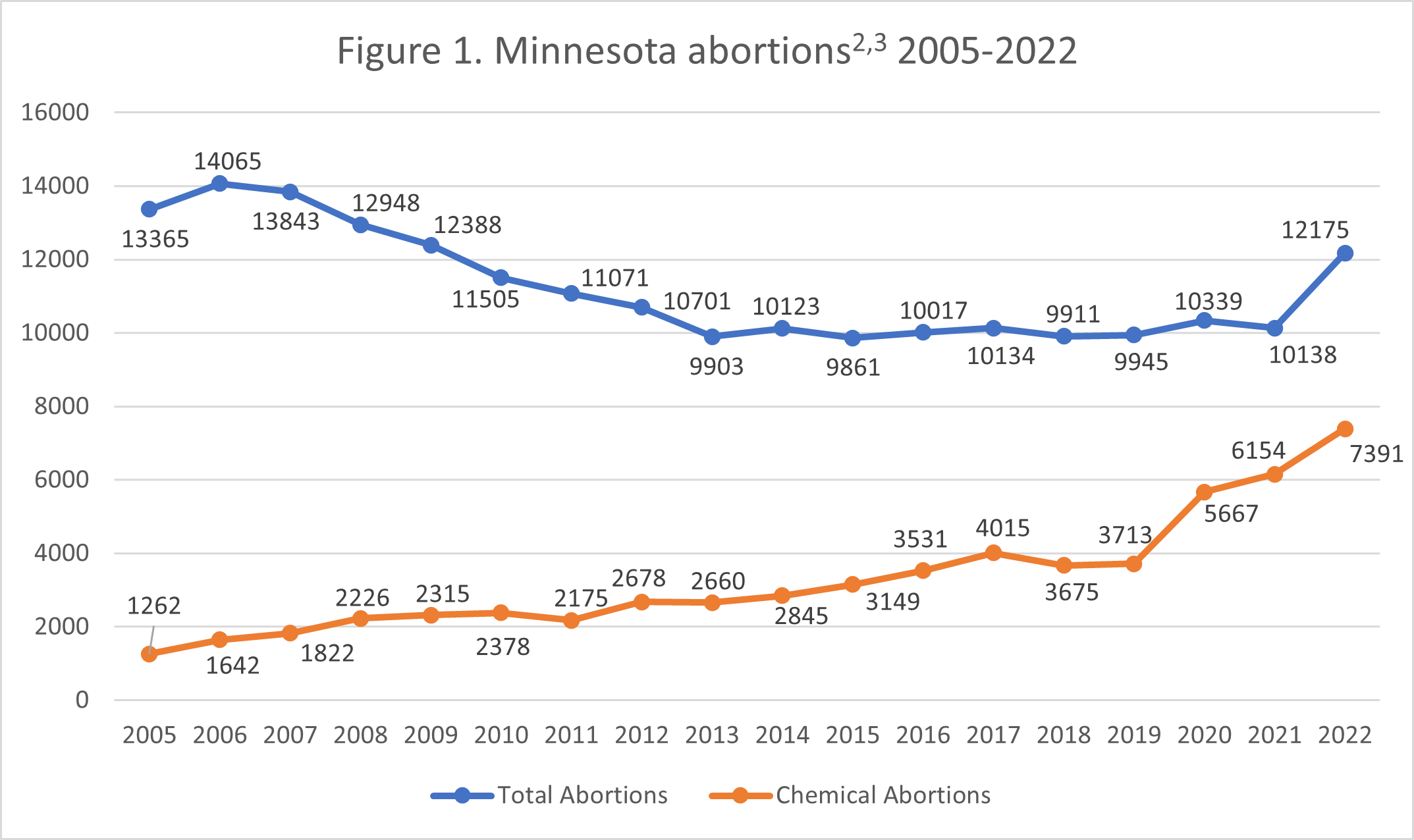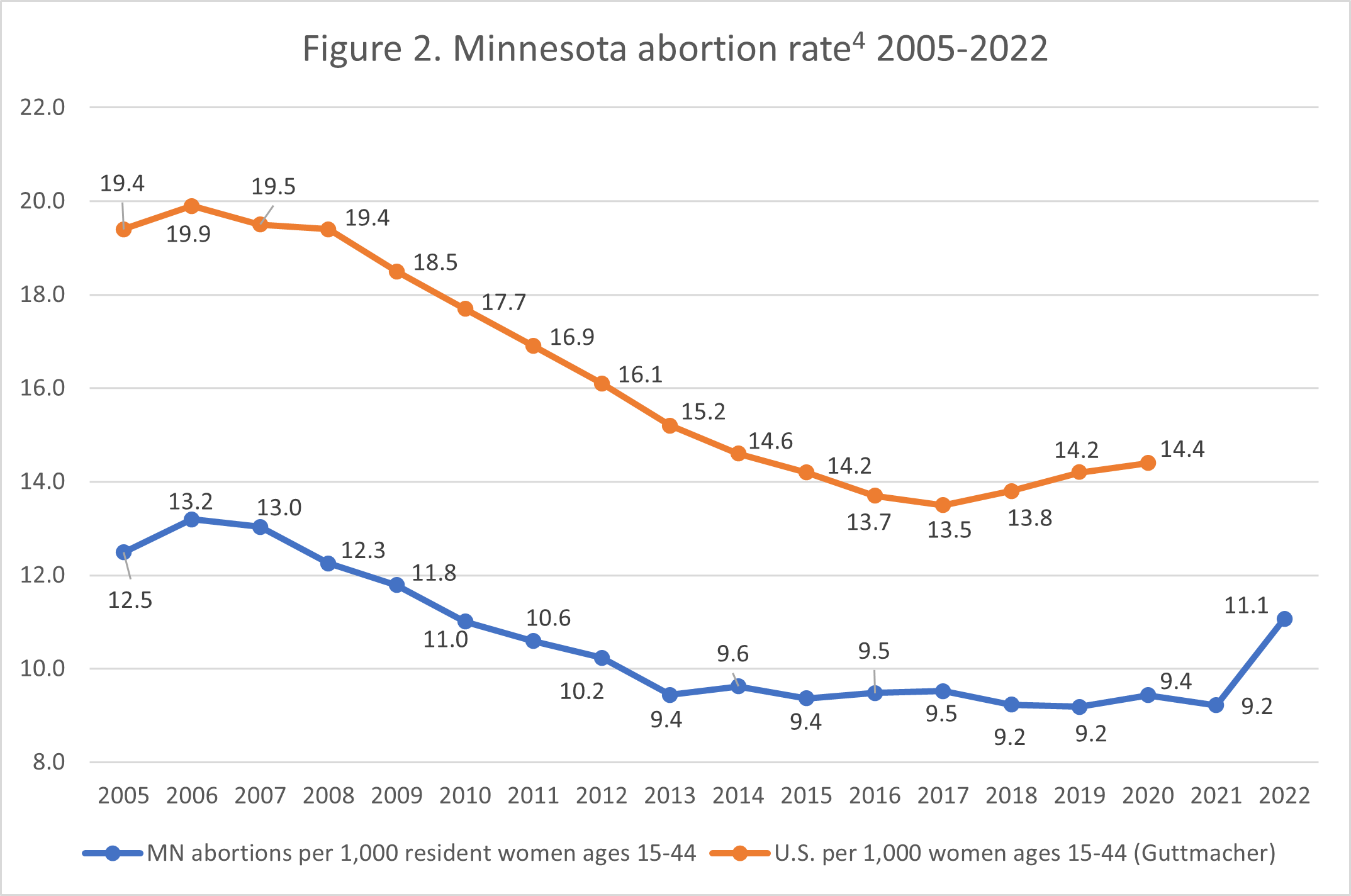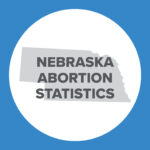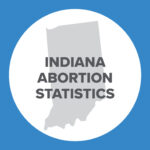Abortion Reporting: Minnesota (2022)
Minnesota’s annual abortion report for 2022 was published online by the Minnesota Department of Health in July 2023. The report shows that Minnesota’s abortion total increased from 2021.
Statistics and Changes in Minnesota Abortions, 2021-2022

Abortion Totals and Trends
In 2022, there were 12,175 abortions reported in Minnesota, an increase of 20 percent from 2021 when there were 10,138 abortions (Fig. 1). Chemical abortions made up 61 percent of the total, increasing by 20 percent from 6,154 in 2021 to 7,391 in 2022. The Charlotte Lozier Institute (CLI) estimates that Minnesota’s abortion rate also increased by 20 percent from 2021 to 11.1 abortions per 1,000 women ages 15 to 44 (Fig. 2). As of August 2023, 14 states have released 2022 abortion statistics, with 10 states indicating that abortions had increased from the prior year.
State Report Summary
Eighty-three percent of Minnesota abortions reported in 2022 were carried out on state residents, while 17 percent were performed on women from other states, an increase from 10 percent in 2021. The number of women from North Dakota, Iowa, and Texas seeking abortions in Minnesota all tripled compared to the previous year, with the number of women from Texas coming to Minnesota increasing eight-fold. The increases in women traveling to Minnesota from out-of-state may be explained by the apparent unenforceability of any gestational abortion limits in Minnesota and the pro-life laws in the aforementioned states that were allowed to go into effect after the Dobbs decision.
A majority of Minnesota abortions were performed on women in their twenties, with 28 percent on women ages 20 to 24 and 27 percent on women ages 25 to 29. Thirty-two percent were obtained by women in their thirties. Nine percent were performed on girls under the age of 20, including three percent on girls under age 18.Four percent were performed on women over the age of 40. The age of women was not reported for 22 abortions.
Forty-eight percent of the abortions reported in 2022 were performed on white women, 25 percent on black women, and six percent on Asian women. Three percent were obtained by American Indian women, and 12 percent were on women of other races. Race was not reported for seven percent of the abortions. CLI estimates that Minnesota’s black abortion rate was 31.4 abortions per 1,000 women ages 15 to 44, nearly five times the white rate of 6.7. Eighty percent of the abortions were on non-Hispanic women and 11 percent on Hispanic women, while ethnicity was not reported for eight percent.
Unmarried women accounted for a large majority of the abortions reported in Minnesota (80 percent), compared to just 13 percent on married women and seven percent on women of unknown marital status. The majority of Minnesota abortions were performed on women who graduated from high school: 26 percent were obtained by women with a high school diploma as their highest level of education, 21 percent on women who had attended some college, and 25 percent on women with a college degree. Nine percent of Minnesota abortions were performed on women who had not graduated from high school, while 19 percent were on women whose level of education was not reported.
Fifty-eight percent of Minnesota abortions were obtained by women with a previous live birth, including over 22 percent on women with one prior live birth and more than 35 percent on women with two or more live births. Thirty-eight percent of the abortions reported in 2022 were performed on women who had previously had an abortion. Twenty-two percent were obtained by women with one previous abortion, and 16 percent by women with more than one prior abortion. Forty-two percent of Minnesota abortions were performed on women with no prior live births, and 62 percent were on women with no previous abortions. Twenty percent were obtained by women who had previously suffered a miscarriage.
A majority of the abortions reported in Minnesota, 61 percent, were chemical abortions. Most of the chemical abortions were induced using mifepristone (59 percent of all abortions reported in Minnesota), while two percent were induced using misoprostol as the principal drug. There was one “other” chemical abortion, a category that includes late-term induction abortions. Just under one-third of the abortions (32 percent) were performed via suction curettage and seven percent were dilation and evacuation procedures. There was one abortion performed using hysterectomy/hysterotomy, and another was performed via some other type of surgical procedure.
Over two-thirds of the abortions (66 percent) took place earlier than nine weeks of gestation. Sixteen percent were performed between nine and 10 weeks, and six percent occurred between 11 and 12 weeks. Five percent were performed between 13 and 15 weeks, and four percent between 16 and 20 weeks of gestation. There were 227 abortions (two percent) at 21 weeks of gestation or later. Gestational age was not reported for 85 abortions.
In 2022, there were 104 intraoperative complications, or complications identified at the time of the abortion procedure and reported on the abortion reporting form.1 Multiple complications could be reported for a single abortion. There were five cases of both cervical lacerations and heavy bleeding or hemorrhage. There was one case of uterine perforation. Lastly, there were 93 unspecified complications. There were 12,073 abortions reported with zero complications.
Additionally, there were 36 postoperative complication reports submitted with information on 39 complications. The complication reports do not indicate where the abortion was performed or the residence of the woman, so Minnesota’s report cautions that this data cannot be used to produce a complication rate per abortion procedure. There were 19 failed abortions in which the pregnancy was ongoing and 13 incomplete abortions in which pieces of the unborn baby or other pregnancy tissue were left in the woman’s uterus. There were three instances of cervical laceration that required sutures (stitches) or other forms of repair and two instances each of heavy bleeding or hemorrhage and infections that required hospitalization.
Minnesota is one of 17 states to use its own tax dollars to fund abortion, and 41 percent of Minnesota abortions were funded through public assistance in 2022. Eighteen percent were covered by private insurance, and 42 percent were self-pay.
Minnesota requires abortion providers to report the methods used to dispose of the bodies of unborn babies killed by abortion. In 2022, 25 percent were cremated, and 0.2 percent (24 abortions) were buried. Seventy-five percent had not reached the stage of development to be legally required to be reported as fetal remains.
A majority of abortions (58 percent) were performed in Planned Parenthood’s four Minnesota centers. Eight percent were reported by Whole Woman’s Health, seven percent by Robbinsdale Clinic, and four percent by Women’s Health Center. An additional 22 percent were reported by hospitals, doctors’ offices, and small clinics, an increase from just seven percent in 2021. Overall, 82 percent of Minnesota abortions occurred in clinics and one percent occurred in hospitals (147 abortions as outpatient procedures and seven on an inpatient basis). Ten abortions were performed in ambulatory surgery centers. One abortion was performed in a doctor’s office. The type of facility was not reported for 17 percent of Minnesota abortions.
Ninety-five doctors performed abortions in Minnesota in 2022. Not quite half (45) of the doctors performed fewer than 10 abortions each, including 28 doctors who reported just one abortion each. Overall, 70 doctors performed fewer than 100 abortions each. Nineteen doctors performed between 100 and 499 abortions, and three doctors performed between 500 and 999 abortions. Two doctors performed between 1,000 and 1,499 abortions, and one doctor performed more than 1,500 abortions in 2022 (1,893 abortions).
No babies were reported to have been born alive during abortions in Minnesota in 2022.
In 2022, women undergoing abortions in Minnesota were asked to share their reasons; women could offer more than one reason. The most frequent reasons were elective: “Does not want children at this time” (offered by 60 percent of the women undergoing abortion in Minnesota); economic reasons (given by 12 percent of the women); and emotional health (nine percent). Only five percent of the abortions were performed because of the woman’s physical health, while 35 abortions were performed because a major bodily function was endangered by the pregnancy. Fifty-two abortions were performed because a woman’s pregnancy was a result of rape and nine due to incest. Two percent of the abortions were due to fetal anomalies. Another two percent were performed for other reasons. Thirty-one percent of the women declined to share a reason.
Changes to Abortion Reporting in 2022 and Beyond
On July 11, 2022, a Ramsey County District Court found the state’s informed consent statutes to be unconstitutional in the case of Doe v. State. Because of this decision, the Minnesota Department of Health can no longer require informed consent reporting to be included in abortion reporting forms and has removed all informed consent reporting from its 2022 (and all future) annual report.
In addition to this change, in 2023 the Minnesota legislature passed and Governor Tim Walz signed SF2995, which significantly changes data collection and reporting requirements for 2023 and future data. All future reports will be significantly less detailed and transparent, with the legislation requiring that reports no longer include information on:
- The reasons why women had an abortion,
- The number of prior abortions and miscarriages that woman had,
- How an abortion was paid for,
- How many babies were born alive following a failed abortion, and whether any actions were taken to preserve their lives after being born.
This legislation also pushes back the deadline by which the state’s annual report must be published, from July 1 to December 31.
State Ranking
In CLI’s 2016 analysis of abortion reporting across the nation, Minnesota’s reporting was ranked second best. Only Oklahoma had better abortion reporting. However, given the state’s decline in abortion reporting in 2022 and 2023, that ranking will change drastically in the future. To maintain its current ranking, Minnesota could repeal all the changes contained in SF2995. Additionally, Minnesota could report the number of complications caused by each type of abortion procedure and strengthen its protocol for ensuring that all abortions performed in the state are reflected in its data.


- Statistics on abortion complications reported here represent a minimal number of deaths and complications, as this data is collected in a non-systematic and non-verifiable way. As such, this data cannot be used to calculate either an accurate abortion mortality rate or an accurate abortion complication rate for the state.
- In the 2022 annual abortion report, the Department of Health corrected its 2021 abortion total and noted that two more abortion reports had been submitted after the submission deadline of April 1, 2022, bringing the total to 10,138 abortions occurring in Minnesota in 2021.
- Minnesota updated its abortion procedure categories in 2017. To allow for comparison with earlier reports, “other” chemical abortions, which include labor induction abortions, are excluded from the chemical abortion total. There were three “other” chemical abortions in 2021.
- National rates were calculated by Guttmacher Institute. Minnesota rates were calculated by CLI using the following formula: (total number of abortions performed in Minnesota ÷ number of resident women ages 15-44) x 1,000. Rates may differ slightly from previous CLI articles due to revised population estimates. Population estimates were obtained from CDC WONDER. Estimates for 2005-2009 are intercensal estimates of the July 1 resident population. Estimates for 2010-2019 are Vintage 2020 postcensal estimates of the July 1 resident population. Estimates for 2020-2022 are Vintage 2021 postcensal estimates of the July 1 resident population as the CDC has not yet released 2022 population estimates. Estimates were produced by the U.S. Census Bureau and the National Center for Health Statistics.

























